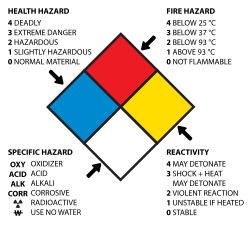NFPA 704
NFPA 704, also known as a Safety Square, is a tilted square-shaped sign or picture that tells people about the hazards of a chemical compound.[1] It was designed in 1960 by the National Fire Protection Association, as a way of quickly telling firefighters and other emergency workers what kind of dangers might be nearby.[2]
The sign is made of four smaller diamonds: a red one on top, a yellow one on the right, a white one on the bottom, and a blue one on the left. Numbers or symbols in these boxes tell how dangerous the chemical is.
The red diamond tells how flammable the chemical compound is: how easily it catches fire. The yellow diamond tells about reactivity: how quickly the compound reacts with other materials. (For example, some chemicals, like ammonium nitrate, explode when they touch water; this is an example of reactivity.) The blue diamond tells how dangerous the chemical is to a person's health. Each of these three diamonds - red, yellow, and blue - are given a score between 0 and 4. A score of 0 means there is no danger. A score of 4 means there is the worst possible danger.[3]
The white diamond has codes for "special hazards." For example, if a chemical like ammonium nitrate should not touch water because it will explode, a W with a line through it will be written in the white diamond.[3]
Codes
| Flammability (red)[1] | |
|---|---|
| 0 | Will not burn. Examples: carbon tetrachloride, concrete, stone, and sand. |
| 1 | Must be heated for a long time before it will burn. Will not catch fire until it is heated to at least 93.3 °C (200 °F). Example: cooking oil. |
| 2 | Must be heated to somewhat high temperatures before it can catch fire. Will catch fire at temperatures between 37.8 and 93.3 °C (100 and 200 °F). Example: diesel fuel. |
| 3 | Can catch on fire in almost all temperatures. Examples: gasoline and acetone. |
| 4 | Can catch on fire in the air at regular room temperatures, and burn very easily. These chemicals catch fire at less than 22.8 °C (73 °F). Examples: acetylene, propane, and liquid hydrogen). |
| Health (blue)[1] | |
|---|---|
| 0 | No danger to anyone's health. No special protections are needed. Examples: water, wood, and paper. |
| 1 | Exposure would cause minor pain or injury. Examples: acetone, sodium chloride (salt). |
| 2 | Could injure a person if they were exposed to a lot of this material at once, or a little bit of the material for a long time. Example: hydrogen peroxide. |
| 3 | Toxic. Breathing in, touching, or getting this material on the skin could cause very bad injury. Examples: chlorine, liquid hydrogen and carbon monoxide. |
| 4 | Very toxic. Getting even a very small exposure to this material could kill a person or hurt them very badly. Examples: cyanide and phosgene. |
| Instability/reactivity (yellow)[1] | |
|---|---|
| 0 | Very stable, even during fires. Does not react with water. Example: helium |
| 1 | Usually stable, but can become unstable at high temperatures. Example: magnesium. |
| 2 | Can react violently with water, or form explosive mixtures with water. Examples: white phosphorus, potassium, and sodium. |
| 3 | Can explode if heated or shocked; or explodes when it touches water. Example: ammonium nitrate. |
| 4 | Can spontaneously explode at normal temperatures. Example: nitroglycerin. |
| Special notice (white) | |
|---|---|
| The white "special notice" area can contain several symbols. There are only three official symbols that can go in this section.[3] | |
| OX | The material is an oxidizer: it allows chemicals to burn without an air supply. Examples: ammonium nitrate and hydrogen peroxide. |
| ₩ | Reacts with water in an unusual or dangerous way; this chemical should not touch water. Examples: sodium and sulfuric acid. |
| SA | The chemical is a simple asphyxiant gas. This means it decreases the amount of oxygen in the air. This symbol is only used when the gas is nitrogen, helium, neon, argon, krypton, or xenon.[3] |
| Non-standard symbols (white) | |
|---|---|
| Sometimes, other codes are put in the white triangle. These are not official NFPA codes.[3] | |
| COR | Corrosive (can burn through things). Example: sulfuric acid, hydrochloric acid. |
| BIO or |
Biological hazard (a living thing, like a virus, that is dangerous). Examples: flu virus and rabies virus. |
| POI | Poisonous. Example: strychnine. |
| RA, RAD or |
Radioactive. Example: plutonium, radium. |
| CRY or CRYO | Cryogenic (these chemicals create very low temperatures that can injure people). Example: liquid nitrogen, liquid oxygen. |
NFPA 704 Media
NFPA 704 safety squares on containers of ethyl alcohol and acetone.
NFPA 704 placard of hydrofluosilicic acid. Notably, it is using the nonstandard COR sign.
Related pages
References
- ↑ 1.0 1.1 1.2 1.3 "NFPA 704: Standard System for the Identification of the Hazards of Materials for Emergency Response". NFPA.org. National Fire Protection Association. 2016.
{{cite web}}: Missing or empty|url=(help) - ↑ "Proposed Amendments on Revisions to the Recommended System for the Identification of The Fire Hazards of Materials / NFPA No. 704M — 1969" (PDF). Archived from the original (PDF) on 2016-03-03. Retrieved 2016-01-29.
- ↑ 3.0 3.1 3.2 3.3 3.4 "Frequently Asked Questions on NFPA 704" (PDF). NFPA.org. National Fire Protection Association. Archived from the original (PDF) on July 16, 2017. Retrieved January 29, 2016.



